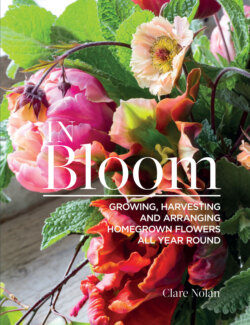Читать книгу In Bloom - Clare Nolan - Страница 23
На сайте Литреса книга снята с продажи.
ОглавлениеThe flower grower’s year
SPRING
EARLY SPRING
Sow half-hardy annuals like amaranthus, cosmos, and zinnia undercover about 6-8 weeks before the risk of frost in your area has passed.
Direct sow hardy annuals like cerinthe, nigella, and cornflower once the ground warms up.
Start off anemone corms and ranunuclus claws by soaking and pre-sprouting (page 63), grow on undercover.
Start off dahlia tubers in pots undercover.
Plant out autumn sown sweet peas and sow another batch of seed for follow-on flowers.
Order late summer/autumn flowering bulbs and biennial and perennial seed (to sow in mid-summer).
MID SPRING
Continue to sow hardy annuals direct for a succession of flowers.
Prick out seedlings grown undercover and pot, continue to grow on indoors, potting again if needed (watch for little white roots trying to escape out of the holes at the bottom of the pot).
Plant summer/autumn flowering bulbs. Plant gladioli bulbs in small batches every couple of weeks for the next two months for an extended flowering season.
Begin to harden off plants started off indoors, begin with the hardy annuals first, then the half-hardy annuals.
Plant out hardy annuals once they are hardened off properly. These can go out about a month or so before the risk of frost has passed, but watch out for any potential hard frosts and use fleece to protect if necessary.
LATE SPRING
Continue to harden off plants and seedlings started indoors – putting them outside on warm days and the plant out once risk of frost has passed.
Once hardened off, plant out all seedlings and plants started indoors – keep an eye on the weather and protect with fleece if a rogue late frost is forecast.
Position supports where needed before the plants put on too much growth.
Keep an eye on the moisture levels and begin watering if it’s a dry spring.
SUMMER
EARLY SUMMER
Continue to sow batches of annuals for follow-on flowers – pulling up plants once they become less productive and replacing them with new ones. Think of anything sown before mid-summer as this season’s crop – anything sown after will be for the next season the following year.
Make homemade comfrey tea (page 55) and start feeding plants every two weeks a seaweed feed and then the tea once it’s ready. Give heavy feeders a bit extra; I give my roses a specialist rose feed that is high in potassium and apply a good-quality tomato feed to my dahlias.
MID-SUMMER
Sow perennials and biennials like foxgloves, sweet william, and honesty for flowers next year.
LATE SUMMER
Order spring/early summer flowering bulbs like alliums, daffodils, lilies, anemones, rannunculus, and tulips to ensure you get the varieties you want.
AUTUMN
EARLY AUTUMN
Plant out mid-summer sown biennials like foxgloves, sweet william, or honesty.
Sow hardy annuals like cerinthe, nigella, and cornflower for early flowering next year either direct or undercover to overwinter indoors.
Plant spring/early summer flowering bulbs like daffodils, alliums, and lilies (but not tulips yet).
Start off anemone corms and ranunuclus claws by soaking and pre-sprouting (page 63), then planting out or overwintering in a greenhouse.
Collect seed from spend blooms, clean and either sow immediately or store for the following season.
MID AUTUMN
Sow sweet peas
Plant out potted perennial plants and shrubs.
Divide perennials to increase stock.
Dig up and store gladioli bulbs, and dahlia tubers if your garden is very cold or the soil is wet.
Clear beds and prepare for the following season – apply mulch of well-rotted compost and manure.
LATE AUTUMN
Plant tulip bulbs.
Pot up bulbs like paperwhites and amaryllis for forcing over winter.
WINTER
EARLY WINTER
Plant bare-root trees and shrubs.
MID-WINTER
Check on dahlia tubers and gladioli corms stored overwinter – watch for any signs of mold and water sparingly if they are starting to shrivel.
Order annual seeds
LATE WINTER
Sow slow-growing annuals like larkspur and cup and saucer.
Prepare the ground for sweet peas if weather permits – digging in plenty of well-rotted manure or compost and fix the supports in place.
Sow a second batch of hardy annuals undercover.
